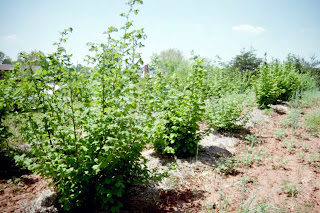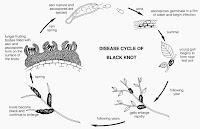My wife and I spent a great deal of time on the property clearing the out overgrowth of thorn bushes and other unwanted trash in our woods last fall when we came across a hickory tree with these strange black knobs or growths all over its branches. We discovered that the hickory tree was not the only tree with these growths. We were not sure exactly what they were but the knots didn't look like they were helping the trees in any way. We decided to go ahead and cut off all of the branches that had this growth on them after which we tossed them into the fire. It wasn't until recently we discovered what those knobs on the branches were, Black Knot Disease. Below is a great article about the disease and how to treat it, and after reading about this disease it sounds like we made the right decision.
http://plantclinic.cornell.edu/FactSheets/black_knot/blacknot.htm
Introduction
Black knot disease occurs on numerous cultivated and wild plums, prunes, and cherries (Prunus spp.). The disease is characterized by the presence of warty, black galls which may vary in size from 1/2 inch to more that 1 foot in length. In some parts of the Northeast and Midwest, black knot causes serious losses to commercial plum and prune growers. More often, however, the grotesque galls draw the attention from homeowners who want to improve the unsightly appearance of affected landscape trees. Black knot appears to be a minor problem on Prunus species found in forest situations, where susceptible trees are surrounded by many nonsusceptible species of trees. Black Knot is mainly a problem in North America (Canada, the United States and Mexico) where it is indigenous. A record from 1979 indicated the presence of the fungus on pear in Taiwan but no other incidences have been reported from Asia. Currently it is not found in Europe or the EPPO region. The EPPO region consists of 43 European and mediterranean countries that are responsible for international plant protection in their region. Apiosporina morbosa (syn.= Dibotryon morbosum) is listed as an EPPO A1 quarantine pest. Inclusion on the list requires the countries to follow phytosanitary regulations and to make appropriate requirements for admission of plant material in their countries.

Black knot has been reported on 24 species of Prunus but is most commonly found on wild and cultivated plums and cherries. Early publications from the 1950's describing the disease report no cases affecting peach, but a few rare infections have been reported since that time. The disease can be found throughout North America but is most commonly found in the northeast. It was first reported as a destructive disease in Massachusetts in 1811. It was first described in 1821 by L. D. Schweinitz from specimens collected in Pennsylvania. Researchers believe the disease is caused by a native pathogen that was only found in the northeastern states until around 1875, when observations of the disease began arising in the central states.
Young, infected twigs may die during the first year of infection. Larger branches may take several years to display severe damage. The infected trees decline and become more symptomatic with each growing season. The infection stresses the entire tree causing it to weaken, decline, and possibly die. The stress placed on the tree may also make it susceptible to infections by other pathogens. Economically, the trees lose value after a few years. The portions of a branch distal to a knot become stunted, and occasionally knots enlarge to girdle a branch and possibly kill it. Trees with multiple infections become dwarfed and misshapen, markedly reducing their productivity and attractiveness.
Because of the long infection process and disease cycle, this disease is often overlooked by home gardeners and fruit producers. The leaves can mask the symptoms until firmly established infections are in place. Once established, it is very difficult to manage the disease. Commercial growers often discover the disease more quickly because they regularly inspect their trees during routine crop management. Awareness and strict monitoring of susceptible plants should be a priority for all home gardeners and commercial growers.
Symptoms
The disease is characterized by the presence of thick, black, irregular swellings on the twigs (Fig. 1). The presence of these symptoms is often first noticed in the winter season when they are unobscured by leaves. However, the fungal disease-causing agent has been present for quite some time. The pathogen's presence disrupts the normal growth of the twigs and a tumor-like growth forms at the infection site. Infections may take place as much as a year or more prior to the development of these characteristic "knots", therefore, the swellings are normally not noticed until the winter of the second season of infection. It takes a keen observer to notice the subtle, initial symptoms present during the first season of infection.
The first symptoms appear as small, light brown swellings of the current or previous season's growth.. By the next season the swellings turn olive-green in color with a velvety texture. Over this growing season the knots darken and appear to have a hard, brittle texture (Fig. 2). The hard, black knots are the typical symptoms associated with the disease.
Knots vary in size from approximately 1-30 cm (0.5 to 12 in.) in length and from minute measurements to 5 cm (2 in.) in circumference. The infected twigs often appear bent at the tips because of extra cellular growth on one side. Trees with heavy infections may contain numerous knots. Some of the older knots may appear white or pink in color. This discoloration is often seen in late summer and is caused by the fungal parasite, Trichothecium roseum.
Disease Cycle
The fungus overwinters in the knots. About the time of bud emergence in the spring, the first ascospores are forcibly discharged from the ascostromata following a period of warm, wet weather. Apparently very short periods of wetness (only a few hours) are enough to prompt ascospore discharge. Temperatures between 16 and 27oC (60-80oF) are ideal for the dissemination, germination, and infection of new plant tissue. Recent studies have confirmed and concluded that rainfall and temperature are the key factors in the release of spores and that the duration of the rainfall or wet period is not a factor.
The ascospores are spread by air currents and rain splashing. Mainly the succulent green shoots and, occasionally, wounded tissues are most susceptible to infection by ascospores. Ascospore discharge continues to occur for 2-3 weeks after bloom. Infections take place during this time but may continue for a longer time period if susceptible host plant tissue is available. The germinating ascospores have the ability to penetrate unwounded surfaces of elongating, green shoots directly.
Figure 3. The early stages of knot formation results in only small galls. (provided by Dr. Phil A. Arneson, Cornell University)
 Figure 4. As knots develop, they become very soft in texture and are covered with olive-green conidia. (provided by Dr. Phil A. Arneson, Cornell University
Figure 4. As knots develop, they become very soft in texture and are covered with olive-green conidia. (provided by Dr. Phil A. Arneson, Cornell University)
The knots develop very slowly, and by the end of the summer they appear only as small galls that might easily be overlooked (Fig. 3). Further development does not occur until the following spring when the knots enlarge very rapidly. They initially are quite soft in texture and become greenish-brown in color as conidia develop over their surfaces (Fig. 4). The conidia are disseminated by wind and splashing rain but probably do not figure as prominently as the ascospores in establishing new infections.
By the second summer after infection, the knots have enlarged considerably and begin to change to a hard, coal-black structure. The old knots enlarge every year by advancing at the margins. The fungus mycelium can also spread internally and give rise to new galls some distance from the original knot. The central, older portions of the knot eventually break down and are invaded by boring insects.
Black knot disease cycle. (provided by Dr. Wayne Wilcox, Cornell University, NYSAES, Geneva, NY)
Management Strategies
Cultural management
Cultural management strategies are important in black knot management. Sites containing Prunus species should be monitored on a scheduled basis for possible infections. The main strategy to lower disease incidence is the removal of sources of inoculum. All shoots and branches bearing knots should be pruned out during the winter. This pruning should be completed before ascospore discharge begins in the spring, usually about the time that the buds first break. To be sure that even the unseen internal mycelium is removed, the cut should be made at least 15-20cm (6-8 in.) below the knot. Winter is also a good time to look for and remove sources of inoculum in nearby wild Prunus species in hedgerows and woodlots. The knots are capable of producing ascospores for some time after removal from the tree. Therefore, they should be burned, buried, or removed from the site regardless of the time of year the pruning takes place.
Genetic resistance
When selecting trees for a new planting, consider selecting varieties with known resistance. Varieties may vary in their ability to tolerate or resist an infection. Black knot resistance is as important as fruit characteristics, tree size, and flowering time. Up-to-date listings of varieties with high levels of resistance are often available from local extension offices. The plum variety President has shown high resistance. Moderately resistant varieties include: Methley, Milton, Early Italian, Brodshaw, Fellenberg, Shiro, Santa Rose, and Formosa. Shropshire and Stanley are very susceptible.
Site selection
Consider the site location. Avoid planting new trees near areas with known problems such as abandoned orchards or where wild varieties have been observed with the disease. When possible, remove wild varieties of the trees from the area.
Biological control
Interest in biological control agents is increasing because of the loss of certain fungicide registrations and the fact that applicators would prefer to reduce their exposure to pesticides. A possible biological control agent for black knot may be the fungal parasite, Trichothecium roseum, introduced in the symptoms section.
Chemical management
Fungicides to manage black knot are normally only recommended for commercial fruit production in New York State. At this time, there are no products are currently registered in New York for use on home orchard fruit trees or ornamentals for managing Black Knot. Homeowners should practice cultural controls for both ornamental and home orchard fruit trees that show evidence of this disease
 How many people can say that Martha Stewart stopped by for a visit? You can see the Martha Stewart's episode that featured Franklin Garland of Garland Truffles. Click Here
How many people can say that Martha Stewart stopped by for a visit? You can see the Martha Stewart's episode that featured Franklin Garland of Garland Truffles. Click Here You know you can make a good omelet when Martha Stewart invites you onto the show to cook one. Click Here!
You know you can make a good omelet when Martha Stewart invites you onto the show to cook one. Click Here!










